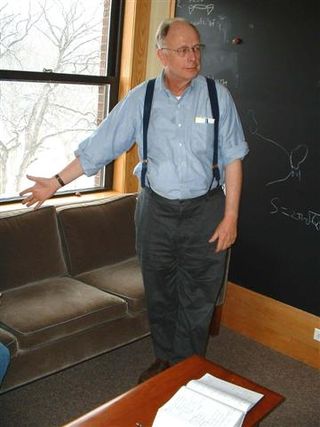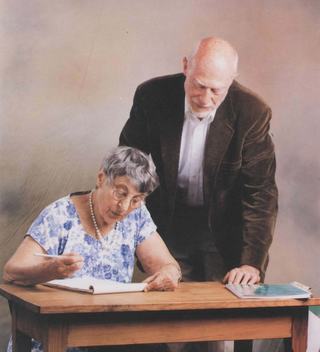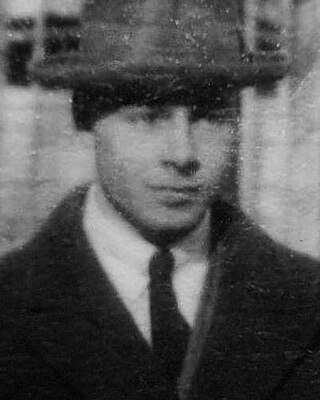Related Research Articles

In physics, gravity (from Latin gravitas 'weight') is a fundamental interaction which causes mutual attraction between all things that have mass. Gravity is, by far, the weakest of the four fundamental interactions, approximately 1038 times weaker than the strong interaction, 1036 times weaker than the electromagnetic force and 1029 times weaker than the weak interaction. As a result, it has no significant influence at the level of subatomic particles. However, gravity is the most significant interaction between objects at the macroscopic scale, and it determines the motion of planets, stars, galaxies, and even light.

Max Born was a German-British physicist and mathematician who was instrumental in the development of quantum mechanics. He also made contributions to solid-state physics and optics and supervised the work of a number of notable physicists in the 1920s and 1930s. Born was awarded the 1954 Nobel Prize in Physics for his "fundamental research in quantum mechanics, especially in the statistical interpretation of the wave function".
In philosophy, philosophy of physics deals with conceptual and interpretational issues in modern physics, many of which overlap with research done by certain kinds of theoretical physicists. Philosophy of physics can be broadly divided into three areas:

John Stewart Bell FRS was a physicist from Northern Ireland and the originator of Bell's theorem, an important theorem in quantum physics regarding hidden-variable theories.
Lee Smolin is an American theoretical physicist, a faculty member at the Perimeter Institute for Theoretical Physics, an adjunct professor of physics at the University of Waterloo and a member of the graduate faculty of the philosophy department at the University of Toronto. Smolin's 2006 book The Trouble with Physics criticized string theory as a viable scientific theory. He has made contributions to quantum gravity theory, in particular the approach known as loop quantum gravity. He advocates that the two primary approaches to quantum gravity, loop quantum gravity and string theory, can be reconciled as different aspects of the same underlying theory. He also advocates an alternative view on space and time that he calls temporal naturalism. His research interests also include cosmology, elementary particle theory, the foundations of quantum mechanics, and theoretical biology.
Jorge Pullin is an Argentine-American theoretical physicist known for his work on black hole collisions and quantum gravity. He is the Horace Hearne Chair in theoretical Physics at the Louisiana State University.
William Webster Hansen was an American physicist and professor. He was one of the founders of the technology of microwave electronics.

Leonard Susskind is an American theoretical physicist, Professor of theoretical physics in Stanford University and founding director of the Stanford Institute for Theoretical Physics. His research interests are string theory, quantum field theory, quantum statistical mechanics and quantum cosmology. He is a member of the US National Academy of Sciences, and the American Academy of Arts and Sciences, an associate member of the faculty of Canada's Perimeter Institute for Theoretical Physics, and a distinguished professor of the Korea Institute for Advanced Study.

James Burkett Hartle was an American theoretical physicist. He joined the faculty of the University of California, Santa Barbara in 1966, and was a member of the external faculty of the Santa Fe Institute. Hartle is known for his work in general relativity, astrophysics, and interpretation of quantum mechanics.

Bryce Seligman DeWitt was an American theoretical physicist noted for his work in gravitation and quantum field theory.

Léon Nicolas Brillouin was a French physicist. He made contributions to quantum mechanics, radio wave propagation in the atmosphere, solid-state physics, and information theory.

Llewellyn Hilleth Thomas was a British physicist and applied mathematician. He is best known for his contributions to atomic and molecular physics and solid-state physics. His key achievements include calculating relativistic effects on the spin-orbit interaction in a hydrogen atom, creating an approximate theory of -body quantum systems, and devising an efficient method for solving tridiagonal system of linear equations.
Clifford Martin Will is a Canadian-born theoretical physicist noted for his contributions to general relativity.
Leonard Mandel was an American physicist who contributed to the development of theoretical and experimental modern optics and is widely considered one of the founding fathers of the field of quantum optics. With Emil Wolf he published the highly regarded book Optical Coherence and Quantum Optics.

Edward Leonard Ginzton was a Ukrainian-American engineer.

Robert M. Wald is an American theoretical physicist and professor at the University of Chicago. He studies general relativity, black holes, and quantum gravity and has written textbooks on these subjects.

Thanu Padmanabhan was an Indian theoretical physicist and cosmologist whose research spanned a wide variety of topics in gravitation, structure formation in the universe and quantum gravity. He published nearly 300 papers and reviews in international journals and ten books in these areas. He made several contributions related to the analysis and modelling of dark energy in the universe and the interpretation of gravity as an emergent phenomenon. He was a Distinguished Professor at the Inter-University Centre for Astronomy and Astrophysics (IUCAA) at Pune, India.

Charles W. Misner was an American physicist and one of the authors of Gravitation. His specialties included general relativity and cosmology. His work has also provided early foundations for studies of quantum gravity and numerical relativity.

John Torrence Tate Sr. was an American physicist noted for his editorship of Physical Review between 1926 and 1950. He is the father of mathematician John Torrence Tate Jr.
The following outline is provided as an overview of and topical guide to Albert Einstein:
References
- ↑ Bloch, Felix (1983), "LEONARD ISAAC SCHIFF", Biographical Memoirs, Washington, D.C.: National Academy Press, vol. 54, pp. 300–323, doi:10.17226/577, ISBN 0-309-03391-8 , retrieved September 22, 2009
- 1 2 "Archived copy" (PDF). Archived from the original (PDF) on July 7, 2010. Retrieved October 30, 2009.
{{cite web}}: CS1 maint: archived copy as title (link) - ↑ Seitz, Frederick (1950). "Review: L. I. Schiff, Quantum Mechanics". Bull. Amer. Math. Soc. 56 (2): 191–192. doi: 10.1090/s0002-9904-1950-09377-x .
- ↑ Schiff, Leonard (1949). Quantum mechanics. McGraw-Hill.
- 1 2 3 "Archived copy". Archived from the original on April 10, 2010. Retrieved October 30, 2009.
{{cite web}}: CS1 maint: archived copy as title (link) - ↑ Leonard I. Schiff at the Mathematics Genealogy Project
- ↑ "Guide to the Leonard I. Schiff Papers".
- ↑ "About Varian, Inc". www.varianinc.com. Archived from the original on October 20, 2010.
- ↑ "What is Gravity Probe B?" (PDF). NASA. Retrieved June 29, 2023.
- ↑ Will, Clifford M. (1986). Was Einstein right?: putting general relativity to the test. New York, NY: BasicBooks. pp. 238–239. ISBN 0-465-09088-5.
- 1 2 "Governor's Corner - Residence Halls". Stanford University. Retrieved April 28, 2021.
- ↑ Biographical Memoirs. 1983. doi:10.17226/577. ISBN 978-0-309-03391-6.
- ↑ "APS Fellow Archive". American Physical Society.
- ↑ "Members". National Academy of Sciences. Archived from the original on March 5, 2010. Retrieved March 17, 2010.
- ↑ "Guide to the Leonard I. Schiff Papers".